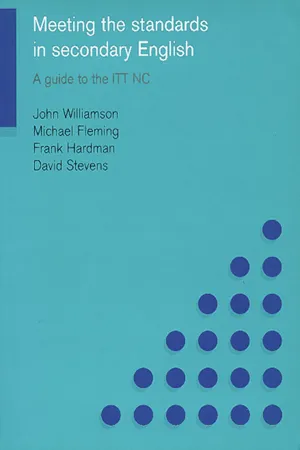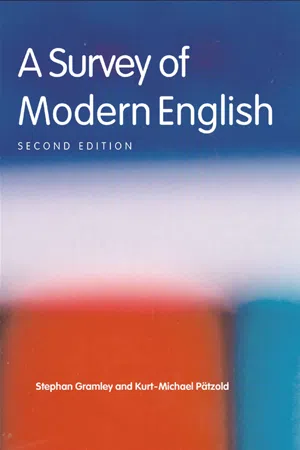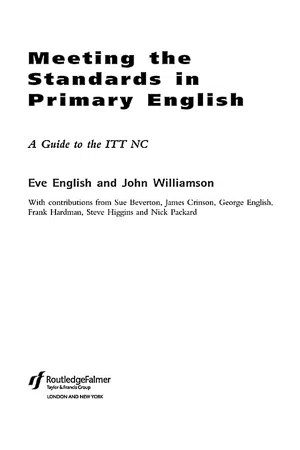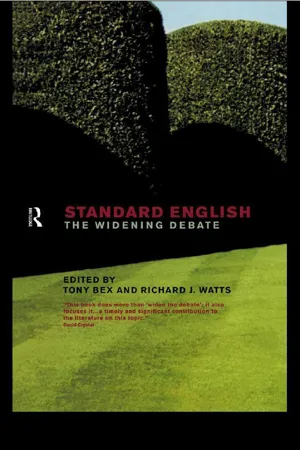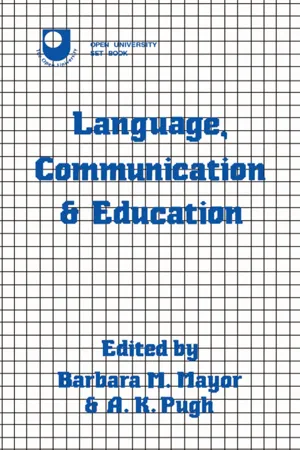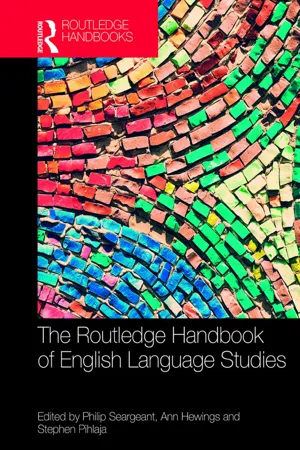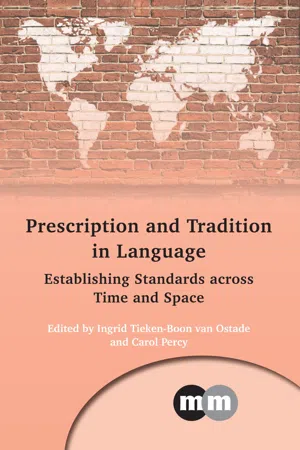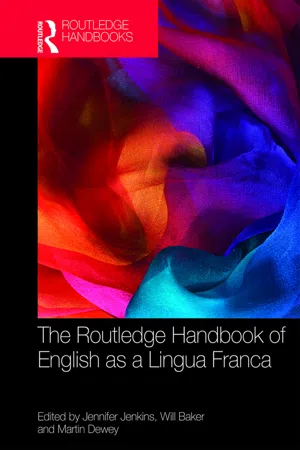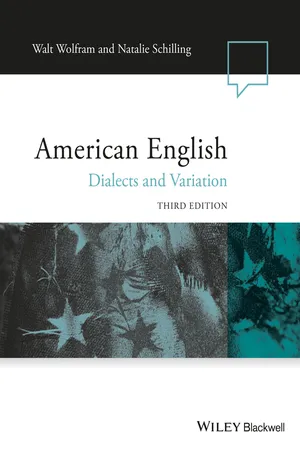Languages & Linguistics
Standard English
Standard English refers to the form of the English language that is widely accepted as the correct and proper way of speaking and writing. It is characterized by its adherence to grammatical rules, vocabulary, and pronunciation that are considered standard within the English-speaking community. Standard English is often used in formal settings, education, and professional communication.
Written by Perlego with AI-assistance
Related key terms
10 Key excerpts on "Standard English"
- eBook - ePub
Meeting the Standards in Secondary English
A Guide to the ITT NC
- Michael Fleming, Frank Hardman, David Stevens, John Williamson(Authors)
- 2003(Publication Date)
- Routledge(Publisher)
Carter’s somewhat jocular reference highlights the point that Standard English is in many ways a dialect which carries with it a particular power and prestige. Standard English is, in fact, a notoriously difficult term to define but one helpful way is to think about the uses to which it is put. Trudgill (1983, p. 17) suggests:Standard English is that variety of English which is usually used in print, and which is normally taught in schools and to non-native speakers learning the language. It is also the variety which is normally spoken by educated people and used in news broadcasts and other similar situations.This should be illuminating for anyone with a good knowledge of the use of English in this country although it does leave the specifics of the grammar and vocabulary unmentioned. Wardhaugh (1992, p. 30) offers another way of thinking about the issue:Standardization refers to the process by which a language has been codified in some way. That process usually involves the development of such things as grammars, spelling books, and dictionaries, and possibly a literature … Standardization also requires that a measure of agreement be achieved about what is in the language and what is not.It may be helpful, then, to think of Standard English as being that dialect of the language whose grammatical features, spelling and vocabulary can be verified in authoritative sources such as those mentioned. However, it should be noted that there is a danger of circularity here. What is Standard English? It’s what you find in grammars and dictionaries. What gets put into grammars and dictionaries? Standard English. Good grammarians and lexicographers (dictionary-makers) try to avoid this difficulty by basing their work on studies of what people actually say and write. Of course, the ‘measure of agreement’ that Wardhaugh mentions probably covers the majority of features of Standard English (which as we have seen are shared by all British English dialects) but we should be aware that the boundaries of Standard English are not clear-cut for several reasons. One of these is illustrated by Activity 1. - eBook - ePub
- Stephan E Gramley, Michael Pátzold(Authors)
- 2004(Publication Date)
- Routledge(Publisher)
Chapter 1 The English language Standards and variation 1.1 Standard English There is little explicit agreement about just how Standard English (StE) should be regarded. Almost everyone who works with English assumes at least implicitly that it exists, but the descriptions made of it – for example, in dictionaries and grammar books, to say nothing of manuals of style – indicate that there is a certain amount of diversity in people’s ideas about StE. Yet, there are dictionaries, grammars and manuals of style, and what they document – some would say prescribe – is what is most often understood by StE (see 1.3 and 1.4). A standard language is used as a model in the speech community at large. In 1.3 you will read about four defining characteristics involved in the process of standardization: selection, acceptance, elaboration and codification. That this is necessary is evident in the cases of so many indigenous languages in Third World countries (see Chapter 14) which for lack of a native standard have adopted a standardized European language such as English, hoping in this way to ease the path to ‘economic prosperity, science and technology, development and modernization, and the attractions of popular culture’ and paying the price of loss of self-expression and diminishment in feelings of cultural worth (Bailey 1990: 87). The result is that ‘the old political empire with its metropolis and colonial outposts has nearly disappeared, replaced by a cultural empire of “English-speaking peoples"’ (ibid.: 83). This quotation indicates that codification can also be overdone if English becomes the instrument of cultural imperialism. In order for English to occupy a more deeply rooted position within post-colonial societies it must draw on the everyday usage of its speakers, and this includes the recognition not only of non-standard forms, but also of non-native ones - eBook - ePub
Meeting the Standards in Primary English
A Guide to ITT NC
- Eve English, John Williamson(Authors)
- 2004(Publication Date)
- Routledge(Publisher)
On the other hand, one major national study of non-standard dialects found that 97.5 per cent of schools surveyed reported the use of them as a demonstrative adjective in constructions like ‘Look at them big spiders’ (Cheshire et al., 1993, p. 65). Now we come to a very important point: the tendency for all dialects to share words and constructions applies also to Standard English because Standard English is a dialect by our definition. If we look at the example above, ‘Look at them big spiders’, we can note that the words ‘look’, ‘at’, ‘big’ and ‘spiders’ are all used with exactly the same meaning as they would have in Standard English. Grammatically there are shared features too, including the use of the imperative ‘look’ and the adjective ‘big’ premodifying the noun ‘spiders’. Standard English has been mentioned several times now and it is perhaps time to try to define it. Any standard language is no more than a dialect with an army and a navy. Cited in Carter, 1995, p. 149 Carter’s somewhat jocular reference highlights the point that Standard English is in many ways a dialect which carries with it a particular power and prestige. Standard English is, in fact, a notoriously difficult term to define but one helpful way is to think about the uses to which it is put. Trudgill (1983, p. 17) suggests: Standard English is that variety of English which is usually used in print, and which is normally taught in schools and to non-native speakers learning the language. It is also the variety which is normally spoken by educated people and used in news broadcasts and other similar situations. This should be illuminating for anyone with a good knowledge of the use of English in this country although it does leave the specifics of the grammar and vocabulary unmentioned. Wardhaugh (1992, p. 30) offers another way of thinking about the issue: Standardization refers to the process by which a language has been codified in some way - eBook - ePub
Standard English
The Widening Debate
- Tony Bex, Richard J. Watts(Authors)
- 2002(Publication Date)
- Routledge(Publisher)
In this chapter, I therefore attempt a characterisation of Standard English. It should be noted that this is indeed a characterisation rather than a strict definition—language varieties do not readily lend themselves to definition as such. We can describe what Chinese is, for example, in such a way as to make ourselves very well understood on the issue, but actually to define Chinese would be another matter altogether. The characterisation will also be as much negative as positive—a clearer idea of what Standard English is can be obtained by saying what it is not as well as by saying what it is. My discussion of this topic will be both a sociolinguistic and a linguistic discussion. (But it will be specifically linguistic: the word ‘ideology’ will not appear again in this chapter.) And it will also, I hope, be informed by references from time to time to the nature of standard and non-standard varieties in language situations beyond the English-speaking world.Standard English is not a language
Standard English is often referred to as ‘the standard language’. It is clear, however, that Standard English is not ‘a language’ in any meaningful sense of this term. Standard English, whatever it is, is less than a language, since it is only one variety of English among many. Standard English may be the most important variety of English, in all sorts of ways: it is the variety of English normally used in writing, especially printing; it is the variety associated with the education system in all the English-speaking countries of the world, and is therefore the variety spoken by those who are often referred to as ‘educated people’; and it is the variety taught to non-native learners. But most native speakers of English in the world are native speakers of some nonstandard variety of the language, and English, like other Ausbau languages (see Kloss 1967 ), can be described (Chambers and Trudgill 1997 ) as consisting of an autonomous standardised variety together with all the non-standard varieties which are heteronomous with respect to it. Standard English is thus not the English language but simply one variety of it.Standard English is not an accent
There is one thing about Standard English on which most linguists, or at least British linguists, do appear to be agreed, and that is that Standard English has nothing to do with pronunciation. From a British perspective, we have to acknowledge that there is in Britain a high status and widely described accent known as Received Pronunciation (RP) which is sociolinguistically unusual when seen from a global perspective in that it is not associated with any geographical area, being instead a purely social accent associated with speakers in all parts of the country, or at least in England, from upper-class and upper-middle-class backgrounds. It is widely agreed, though, that while all RP speakers also speak Standard English, the reverse is not the case. Perhaps 9 per cent-12 per cent of the population of Britain (see Trudgill and Cheshire 1989 - eBook - ePub
- Barbara Mayor, A. K. Pugh(Authors)
- 2005(Publication Date)
- Routledge(Publisher)
It is not surprising, therefore, that there should be some widespread misunderstandings about Standard English. One of these is that it is restricted only to formal kinds of utterance. This idea has gained acceptance, presumably, from its association in people’s minds with contexts and situations where power is exercised—the classroom, the courtroom, the institutions of government. But like any linguistic variety, the standard has its dimensions of variation, including that of informality-formality, since for many people it must function as the medium of everyday conversation. Unlike other varieties, though, it is peculiarly subject to debate and analysis—about what usage is permissible and what is held to be correct. As we shall see, this preoccupation with fixity has often acted as a kind of brake on the natural tendency towards variation and change.The standard is less fixed and monolithic than many suppose, partly because today it has a widely used spoken form (used, moreover, by many people without their realising it!). Since speech, by its very nature, is less amenable to being fixed than writing, the concept of Standard English makes most sense when we are referring to the written word. When we are taught to write, it is Standard English that we are taught. Moreover, this is largely true wherever English is learned in school; and the written standard is much the same in every part of the world where English is known and used.Source: Edited version of Chapter 2 of Leith, D. (1983) A Social History of English, London, Routledge & Kegan Paul, pp. 32–57.Writing, then, is an indispensable component of standardisation. Indeed, it is difficult to conceive of a standard variety without a written form. At the same time, the existence of a writing system does not presuppose the existence of a standard. For instance, West Saxon was used as a written standard in English in the tenth century when no spoken one existed. But once a standard variety has been selected, writing is a powerful agent for its dissemination especially as literacy spreads and printing makes written materials more readily available. As the written forms acquire prestige, and are considered to be ‘correct’, they increasingly exert a pressure on speech. The written standard acts as a norm, a yardstick, and a guide […] - Philip Seargeant, Ann Hewings, Stephen Pihlaja, Philip Seargeant, Ann Hewings, Stephen Pihlaja(Authors)
- 2018(Publication Date)
- Routledge(Publisher)
The standard ideology is promoted through public channels: in the past, standardization has first affected the writing system, and literacy has subsequently become the main influence in promoting the consciousness of the standard ideology. The norms of written and formal English have then been codified in dictionaries, grammars and handbooks of usage and inculcated by prescription through the educational system. Standardization through prescription has clearly been most successful in the written channel: in the daily conversation of ordinary speakers, however, it has been less effective. Indeed, the norms of colloquial, as against formal, English have not been codified to any extent.Precisely because of the fact that what counts as standard is deeply ideological, it is therefore not surprising to note that there is ‘no general consensus’ as to what Standard English is (Bex and Watts 1999: 1). That being said, possibly the best place to start appreciating the contemporary controversies and, indeed, anxieties surrounding standards in English is to consider the assertion made, for example, by Honey (1997, see also the discussion in Cameron 1995) that Standard English is the variety spoken and written by educated speakers.This is a highly controversial attempt to answer the question ‘What is Standard English?’ because it relies on a number of assumptions that appear to be problematic (see Crowley 1999). For one, since there are significant differences between the grammar of spoken and written English, characterizing both as Standard English simply evades the important question of how such differences do not undermine the claim of unity, that is, whether there is a need to distinguish between Standard Written English and Standard Spoken English. This is not a trivial issue because grammatical differences are also the kinds of things that presumably distinguish Standard English from its non-standard counterparts. This issue, if left unaddressed, means that we are left with the further and arguably even more perplexing question of how much variation (and of what kind) is tolerated before the differences in linguistic practices that distinguish Standard Written and Standard Spoken English become characterized as non-standard.A second point is that the group, ‘educated speakers’, that Honey relies on to ground his definition of Standard English is not at all homogeneous, since there are different levels of education and, of course, different educational institutions that enjoy varying degrees of prestige and credibility. All these considerations bring up the question of just what kind of education is needed before a speaker is deemed to be a speaker of Standard English. This in turn raises the highly contentious question of who decides that a speaker has been sufficiently educated to be considered a speaker of Standard English. Simply asserting that other speakers of Standard English are the best judges will not do because of the vicious circularity involved in this line of argument. Claiming that there is an ineffable nature to Standard English that is clearly recognized even by those who may not be competent in it is equally problematic because it shifts the grounds of argument from scholarly debate to matters of taste and faith, and raises the contentious issue of who specifically ought to be the arbiters of such taste and faith. This shift needs to be avoided as far as possible because, as we will see shortly, what counts as Standard English can significantly impact on the social and economic fortunes of individuals. The intersection between Standard English and matters of social justice is too important to be left to the tastes and faith of a (self-)selected few.- eBook - ePub
Prescription and Tradition in Language
Establishing Standards across Time and Space
- Ingrid Tieken-Boon van Ostade, Carol Percy(Authors)
- 2016(Publication Date)
- Multilingual Matters(Publisher)
Part 1 General and TheoreticalPassage contains an image
2 Defining ‘Standard’: Towards a Cross-Cultural Definition of the Language NormDick Smakman and Sandra Nekesa Barasa StandardnessThe standard language is generally considered a linguistic norm which a very large speech community overtly adheres to (Milroy, 1992: 3; Meyerhoff, 2011: 18). Standard languages are different from other varieties of the same language in that they tend to cover a larger area, are often codified and supported by governments and transcend some contact-induced influences (Thomason & Kaufman, 1988). Once they have emerged as standard and gone through a process of acceptance, they are mostly shaped through conscious efforts and are actively spread as an official norm, usually within a country (Smakman, 2012). Traditionally, standard languages can be found used as the linguistic medium in schoolbooks, in official documents, on national mainstream radio and television and, for instance, in official gatherings such as parliamentary sessions (Smakman, 2006). Standard languages tend to be highly visible in many societies. Despite this visibility, however, the standard language is an elusive phenomenon considering that the set of factors its definition depends on is unclear and debatable. Existing models on what a standard language is each take a different aspect of this language as its point of focus: features of the language itself (e.g. Stewart, 1968), position in society (how it is evaluated) (e.g. Hoenigswald, 1966), degree of codification (e.g. Stewart, 1968), characteristics of speakers (e.g. Kloeke, 1951) or, for instance, the historical developmental stages it has gone through, for which Haugen (1966) is usually drawn upon. - Jennifer Jenkins, Will Baker, Martin Dewey, Jennifer Jenkins, Will Baker, Martin Dewey(Authors)
- 2017(Publication Date)
- Routledge(Publisher)
As we have seen above, StE is above all an ideological construct, and notoriously elusive. Equally elusive is the idea of the native speaker – and similarly abundant is the volume of writings that it has spawned (e.g. Coulmas 1981; Davies 2003, 2012; Paikeday 1985). The indeterminate status of the concept has not, however, prevented it from being assigned supreme significance for theoretical, descriptive and applied linguistics. As Brutt-Griffler (2002: 17) observes, “[i]t has become something of an article of faith that the study of linguistics centers on the monolingual individual – the native speaker”. The question of how the concepts ‘Standard English’ – equated, as we have seen, with English as such – and ‘native speaker’ relate is of particular interest in the era of globalization, in which one language has morphed from an insular vernacular with relatively few native speakers to a ‘world language’ used as a lingua franca, predominantly by non-native speakers.p.90It is because StE is represented as ‘proper’ English that it is prescribed as the model for learners of English as a foreign language (EFL). But here, the imposition of a standard is extended even further. Sociolinguists have been at pains to point out that StE is a dialect that can be spoken in a variety of different accents, so there is no standard accent. It is intriguing in this respect to look back at the Kingman Report (1988), a document prepared by a government-appointed committee to enquire into the teaching of English in Britain. In it we find the following statement about StE:33. Since it holds this important role in the written form, it is also used to communicate across local areas and between regions in a spoken form. In its spoken form it may be pronounced with many different regional accents – e.g. Devon, Cheshire, Midlands, Northumbrian, East Anglian. And it is also spoken far beyond these islands in Australian, American, Jamaican and Indian accents, as well as by speakers using English as a foreign language and speaking it with Japanese or Brazilian or Russian accents. There is one accent of English which is used by a minority of speakers in Britain called ‘Received Pronunciation’... This accent is the standard for foreign students of English in Britain, but is not used as the model of English pronunciation in British schools, since speakers may be rightly proud of their regional pronunciation, which identifies where they come from- eBook - ePub
- Laurel Brinton, Alexander Bergs, Laurel Brinton, Alexander Bergs(Authors)
- 2017(Publication Date)
- De Gruyter Mouton(Publisher)
the standardless period of English. The absence of a standard is all the more a defining quality of Middle English because what we regard to be the “beginning of Middle English” coalesces with the disappearance of the so-called “West-Saxon Literary Standard”, so that Roy Liuzza (2000: 145) could claim that “the end of […] scribal training [in the West-Saxon standard] was the beginning of ‘Middle English’”. Moreover, in the last century of the Middle English period the vernacular is generally supposed to be under way towards Modern Standard English. Situated between the disappearing of one written standard and the slow emerging of a new standard, Middle English therefore “exhibits by far the greatest diversity in written language of any period before or since” (Milroy 1992: 156). The reasons for this linguistic scenario lie in the specific language situation resulting from the cultural impact of the Norman Conquest on the one end and the rapidly increasing use of English in writing for various purposes on the other.This chapter is structured in such a way that Section 2 discusses different concepts of the notions “standardization” and “standard” as they are applicable to Middle English. Section 3 subsequently discusses “standardized varieties” of English which have been identified mainly on the ground of unified spellings, and, in the 14th and 15th centuries, also in terms of the spread of dialectally bleached forms which could function supralocally. Section 4 then concentrates on the extensive and intensive elaboration of written English in the 14th and 15th centuries. Section 5 gives a brief summary of the main aspects addressed in the chapter.2Standardization(s) and standards
In general the idea of standardization is based on a concept of fixing and fixity of what would otherwise vary more or less freely. As the prime – and for a long time sole – means of fixing (a) language, writing potentially produces such models that minimize variation. However, writing is a necessary, but not a sufficient, condition for such a specific variety to emerge because it seems to take further socio-pragmatic motivations and textualization efforts for a standard variety to become established. Under “socio-pragmatic” shall be subsumed such standardizing moves that modify written language to serve a wider geographical range of communication. By “textualization efforts” I refer to orientation towards standards already established by existing literate models that will be called “discourse traditions”, a notion specifically apt to account for the unique literary communicative space of the period under consideration. As shall be seen, the former moves reduce variation while the latter efforts enhance variability. - eBook - ePub
American English
Dialects and Variation
- Walt Wolfram, Natalie Schilling(Authors)
- 2015(Publication Date)
- Wiley-Blackwell(Publisher)
In other words, vernacular varieties are the converse of standard dialects in that an assortment of marked English structures sets them apart as being vernacular. Not all speakers of a given dialect necessarily use the entire set of structures associated with their dialect, and there may be differing patterns of usage among speakers of the variety. In fact, attempts to isolate the common core of structures for a particular vernacular often lead to heavily qualified, imprecise descriptions. In Chapter 7, we will discuss the notion of ETHNOLINGUISTIC REPERTOIRE, where a fluid set of linguistic resources can be used to index linguistic identity of members of an ethnic group, offering an alternative to defining a unitary system that characterizes a community of vernacular speakers. We can summarize the features that set apart standard dialects and vernacular dialects as follows: F ORMAL S TANDARD ENGLISH: applied primarily to formal written language and formal spoken language situations; objective standards prescribed by language “authorities”; standards codified in usage books, dictionaries, and other written materials; conservative outlook on language forms. Targeted in prescriptive rules. I NFORMAL S TANDARD/MAINSTREAM ENGLISH: applied to spoken language and relatively informal written communications (e.g. emails); determined by actual usage patterns; recipient judgment essential in determining socially acceptable norms; multiple norms of acceptability, incorporating regional and social considerations; defined by the relative absence of socially stigmatized linguistic structures. V ERNACULAR ENGLISH applied to spoken language and informal written communications (e.g
Index pages curate the most relevant extracts from our library of academic textbooks. They’ve been created using an in-house natural language model (NLM), each adding context and meaning to key research topics.
